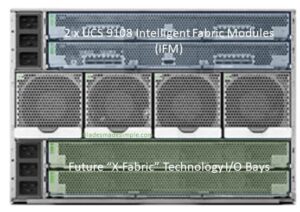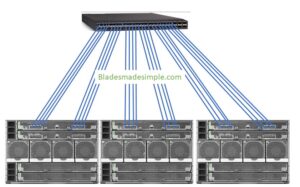Well, it’s about fracken time, Cisco! Today Cisco finally announced information about their next generation UCS chassis. Here’s what you’re going to want to know.
Product Overview
The new product line is known as “Cisco UCS X-Series“, not to be confused with the IBM X-series from years past. Here is an overview of each of the components.
 UCS X9508 Chassis
UCS X9508 Chassis
Chassis – Front
The Cisco UCS X9508 chassis is 7 rack units high with 8 slots. These slots can support compute nodes today, with future designs offering GPU, disk storage and persistent memory. The right side of the UCX X9508 chassis holds up to 6 x 2800W power supplies and offers N, N+1 and N+N redundancy. The chassis is 34.81 inches deep.
Chassis – Rear
Interesting enough, this chassis advertises being “midplane-free” (I’ve heard that before…) The r ear of the chassis holds 4 x hot-swappable dual rotor fans. It also shows 2 I/O bays – a pair on top and a pair on bottom. The top pair hosts 2 x Cisco UCS 9108 Intelligent Fabric Modules (IFMs) designed to connect upstream to a UCS 6400 Series Fabric Interconnect (FI). Each of the UCS 9108 IFMs have 8 x 25-GPs SFP28 uplink ports.
ear of the chassis holds 4 x hot-swappable dual rotor fans. It also shows 2 I/O bays – a pair on top and a pair on bottom. The top pair hosts 2 x Cisco UCS 9108 Intelligent Fabric Modules (IFMs) designed to connect upstream to a UCS 6400 Series Fabric Interconnect (FI). Each of the UCS 9108 IFMs have 8 x 25-GPs SFP28 uplink ports.
I/O Connectivity
The design of the UCS X-Series Modular is to allow UCS 9108 IFMs to connect to UCS 6400 FI’s so I would imagine that each of the SPF28 uplinks would need to be connected. Here’s what I imagine a 3 chassis (24 server) design would look like. Note, this includes only 1 of the pairs of IFM and FI’s. Double this for the 2nd pair.
(updated) Thanks to @HighTechBill I was able to track down a drawing of how the server looks connecting to the IFM.

Another interesting similarity to the Dell EMC PowerEdge MX architecture.
Management
Although the current marketing material doesn’t go into specifics, Cisco makes it very clear that this new UCS-X architecture will be managed solely by Cisco Intersight Managed Mode (IMM). Cisco advertises, “IMM is part of Cisco Intersight, a cloud-operations platform, Software-as-a-Service (SaaS), that uses analytics to deliver proactive monitoring, automation, and optimization of workloads across hybrid cloud environments.” As I learn more about how this works, I’ll let you know.
UCS X210c M6 Compute Node (Blade Server)
 The UCS X201c supports the following:
The UCS X201c supports the following:
- up to 2 x 3rd Generation Intel Xeon Scalable Processors (up to 40 cores)
- 16 DIMMs / CPU
- VIC 14425 modular LAN on Motherboard (mLOM) – 2 ports of 25Gb
- 1 x rear mezz for a 2 port 25Gb VIC 14825
- 1 x front mezz slot for RAID controller or future storage passthrough
- Up to 6 hot-pluggable drives (SAS/SATA/NVMe)
- Up to 2 x M.2 drives with hardware RAID support
Observations and Final Thoughts
There’s a lot to unpack here. I’m not sure why Cisco waited until now to announce this platform, but there are a few things clear to me:
- You can’t mix and match UCS legacy with UCS X-Series. Although the design uses Fabric Interconnects, new chassis and new blade servers will be required.
- No doubt about it – it looks, acts, feels and smells like the Dell EMC PowerEdge MX blade architecture, which debuted in 2018.
- With 2800W power supplies, I’m concerned the configuration options will be limited. Read my last blog post if you want to know why.
- There was no mention of a 4 CPU blade server. I imagine Cisco is waiting for Intel’s Sapphire Rapids next fall. Regardless, this limits the workloads for the UCS X-series to 2 CPU.
- (updated) The IFM has 8 x 25G ports, 16 in total with 2 IFMs in place in the top. Cisco also mentions the servers have 4 x 25G (mLOM) and 2 x 25G (rear mezz). That equals 6 x 25G ports. With 8 blade servers, there’s a need for 24 x 25G ports. Doing the math, there is a potential for oversubscription if you use all 6 ports.
- (updated) I neglected to point out there is no fibre storage attachment on the UCS X-Series chassis or IFM. Storage is limited, currently, to iSCSI or FCoE (or FCoTR.)
I’m glad that Cisco finally revealed what they’ve been working on for years. I wonder how it will compare with the established PowerEdge MX blade architecture, but I guess time will tell. I’d love to hear what your thoughts are in the comments below.
Reference Links
Here are some links to the Cisco web pages if you want to read more:
Meet the UN/BOX: Cisco UCS X-Series Modular System with Intersight Solution Overview
Cisco UCS X9508 Chassis Data Sheet
Cisco UCS X210c M6 Compute Node Data Sheet
 Kevin Houston is the founder and Editor-in-Chief of BladesMadeSimple.com. He has over 20 years of experience in the x86 server marketplace. Since 1997 Kevin has worked at several resellers in the Atlanta area, and has a vast array of competitive x86 server knowledge and certifications as well as an in-depth understanding of VMware and Citrix virtualization. Kevin has worked at Dell EMC since August 2011 is a Principal Engineer and Chief Technical Server Architect supporting the East Enterprise Region at Dell Technologies. He is also a CTO Ambassador in the Office of the CTO at Dell Technologies.
Kevin Houston is the founder and Editor-in-Chief of BladesMadeSimple.com. He has over 20 years of experience in the x86 server marketplace. Since 1997 Kevin has worked at several resellers in the Atlanta area, and has a vast array of competitive x86 server knowledge and certifications as well as an in-depth understanding of VMware and Citrix virtualization. Kevin has worked at Dell EMC since August 2011 is a Principal Engineer and Chief Technical Server Architect supporting the East Enterprise Region at Dell Technologies. He is also a CTO Ambassador in the Office of the CTO at Dell Technologies.
Disclaimer: The views presented in this blog are personal views and may or may not reflect any of the contributors’ employer’s positions. Furthermore, the content is not reviewed, approved or published by any employer. No compensation has been provided for any part of this blog.

Pingback: Cisco (Probably) Isn't Getting Out of the Blade Server Business - Blades Made Simple